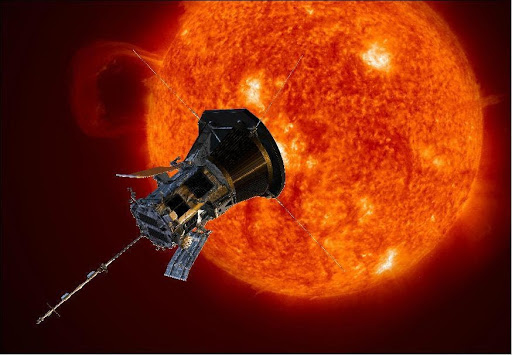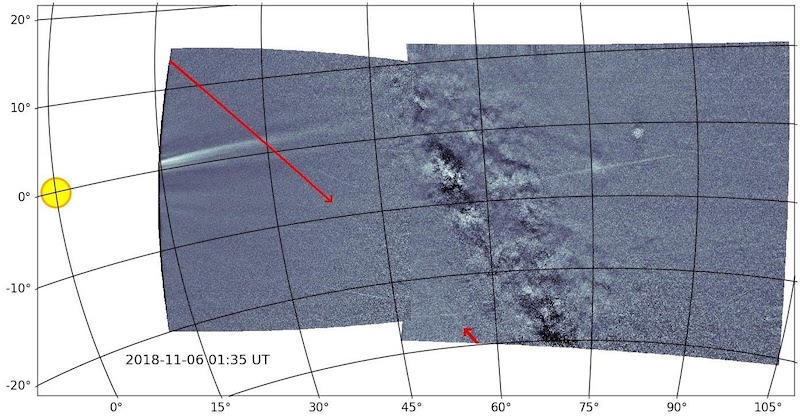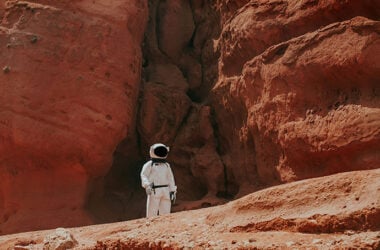How can you find out where the asteroid Phaethon goes? You follow its trail.
Asteroids are mini-planets that orbit our Sun. And it turns out that asteroids, like fairy tale characters, drop breadcrumbs behind them. Okay, not breadcrumbs, but massive rocks. And the trail isn’t merely through the woods. It is 12 million miles long and 60,000 miles wide. This debris makes a visible line in space that shows Phaethon’s elliptical path around the Sun. When Earth crosses this trail, our skies are filled with meteor showers.
Scientists saw the line in space for the first time in fall of 2019 when they got the data back from the Parker Solar Probe. Parker’s main mission is to give scientists a more intimate understanding of what makes the Sun tick. “The Sun is the only star we can examine this closely,” explains Nicola Fox the scientist at NASA who directs this project. “Getting data at the source is already revolutionizing our understanding of our own star and stars across the universe.”

Parker’s orbit resembles a crazy figure 8. It loops in close to the Sun, then zooms back out, then it loops back in, and so on. While it’s getting its solar close up, Parker will investigate how the solar wind is generated, and what makes the Sun’s corona (the outer most layer) so hot. But like a celestial tourist, the satellite is snapping pictures as it approaches the Sun and as it leaves again.
And it was on the way in and the way out again that Parker caught the unexpected images of the trail and also a line of tiny explosions as the asteroid nears the Sun. Researchers can also see the huge amount of debris that makes up the asteroid’s path. “We calculate a mass on the order of a billion tons for the entire trail,” said Karl Battams, a space scientist at the U.S. Naval Research Lab in Washington, D.C. What’s more, the line in the sky is completely unexpected. “No one had ever seen [that part of the trail] or even knew was there, so that’s very exciting!” he said.

How does Parker Solar Probe tell us all this information? Parker is special because its instruments are built to withstand the Sun’s heat, but it is normal in the way it gets information back to Earth. Parker’s cameras take pictures, and other instruments take measurements. The satellite’s computer sees this information as ones and zeros. These packets of information are sent through a transponder that converts ones and zeros into radio waves. And the radio waves are sent back to Earth. Antennas on the ground collect the data and a receiver shifts the data back into the packets that the satellites sent out in the first place.
That’s the standard procedure for satellites. With Parker it is more complicated. The satellite collects huge amounts of data, but those data packets cannot always be sent right away. When Parker is close to the Sun, the Sun interferes with the transmission signals. Also, the satellite is very far away at that point, and getting packets back is harder. So scientists on Earth can get a few small packets of information as the satellite spirals in close to the Sun. Then when Parker swings away from the Sun, they get all the rest.
In 2025, Parker Solar Probe it will come in for its final and closest pass at the Sun, getting within 4 million miles of the Sun’s surface — or for us Earth-bound tourists, about 16 times the distance to our moon.
Each time Parker makes a pass at the Sun, it will also pass the debris from the asteroid, which will give scientists a chance pick up the breadcrumbs as they follow the trail through space.
Learn More
How to yell across the solar system
https://spaceplace.nasa.gov/x-ponder/en/
NASA’s Parker Solar Probe Sheds New Light on the Sun
https://www.nasa.gov/feature/goddard/2019/nasas-parker-solar-probe-sheds-new-light-on-the-sun/
Revealing the Physics of the Sun with Parker Solar Probe
https://www.nasa.gov/feature/goddard/2019/revealing-the-physics-of-the-sun-with-parker-solar-probe
Geminid Meteor Shower’s Parent Debris Trail Spotted for 1st Time (Photo)
https://www.space.com/parker-solar-probe-geminid-meteor-shower-stream.html
Parker Solar Probe
https://www.nasa.gov/content/goddard/parker-solar-probe
The mission
http://parkersolarprobe.jhuapl.edu/The-Mission/index.php
Mission overview (video)
https://www.youtube.com/watch?v=i_z19KPvV1w
What the Parker Solar Probe Won’t Melt
5 Discoveries from Parker Solar Probe
ttps://www.youtube.com/watch?v=ReQAUocScw0
Sounds from the sun
Solar probe video
https://www.exploratorium.edu/video/catching-parker-solar-probe










